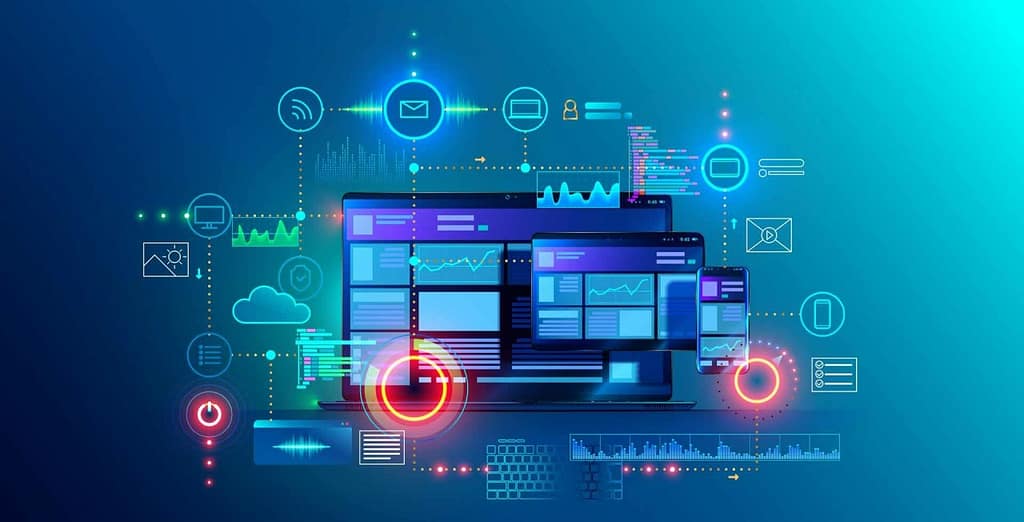IoT devices in environmental monitoring have revolutionized the way businesses oversee and manage their operations across diverse geographical areas. With a centralized dashboard or software platform, organizations can access data from all their monitoring devices in one place.
This remote accessibility eliminates the need for on-site personnel to physically inspect each location, saving time and reducing operational costs. This allows organizations to set up custom alerts and notifications, enabling them to receive immediate notifications when conditions deviate from preset thresholds, and helping them respond promptly to potential issues before they escalate.
Beyond real-time monitoring, IoT devices in environmental monitoring store historical data, which can be invaluable for trend analysis and long-term planning. Businesses can identify patterns and trends in environmental conditions, enabling them to make informed decisions and optimize their operations. In this article, we will explore the role of IoT devices in environmental monitoring and their significance in various industries.

IoT devices in environmental monitoring
IoT, or the Internet of Things, refers to a network of interconnected physical devices and objects that are embedded with sensors, software, and other technologies, enabling them to collect and exchange data over the Internet. These devices can range from everyday objects like household appliances and wearable gadgets to industrial machines and smart infrastructure components.
Now, speaking about IoT devices in environmental monitoring: Sensitive manufacturing processes, particularly in industries like pharmaceuticals and electronics, are highly susceptible to environmental fluctuations. Variations in temperature or humidity can compromise product quality or lead to equipment breakdowns. Timely monitoring through IoT devices enables proactive responses, preventing costly interruptions and preserving the integrity of operations.
The modern global supply chain network is intricate and delicate, making environmental conditions a potential disruptor. By continuously monitoring these conditions, businesses can anticipate and address potential issues, enhancing the resilience and efficiency of their supply chains.
Environmental conditions directly influence energy consumption and resource utilization – therefore, monitoring and optimizing these conditions can lead to significant cost savings. For example, maintaining the right temperature and humidity levels in a warehouse can reduce energy expenses and prolong the shelf life of products.
In many industries, adherence to strict environmental regulations is not only a legal requirement but also a critical aspect of corporate governance. Real-time monitoring helps companies ensure they comply with these regulations, avoiding potential fines and reputational damage.
Remote monitoring: a game-changer
Environmental monitoring devices have revolutionized the way businesses oversee and manage their operations across diverse geographical areas. These devices offer a wide range of benefits beyond basic environmental data collection, making them essential tools for organizations with dispersed assets or multiple locations.
With a centralized dashboard or software platform, organizations can access data from all their monitoring devices in one place. This remote accessibility eliminates the need for on-site personnel to physically inspect each location, saving time and reducing operational costs.
Custom alerts and notifications can be set up, enabling organizations to receive immediate notifications when conditions deviate from preset thresholds. This proactive approach helps in responding promptly to potential issues before they escalate.
Beyond real-time monitoring, environmental monitoring devices store historical data, which can be invaluable for trend analysis and long-term planning. Businesses can identify patterns and trends in environmental conditions, enabling them to make informed decisions and optimize their operations.
What is environmental monitoring?
Environmental monitoring, often referred to as “environmental surveillance” or “environmental assessment”, is a systematic process of collecting, analyzing, and interpreting data related to the environment. This field encompasses various scientific disciplines – including biology, chemistry, physics, and technology – and is essential for assessing the state of the natural world, identifying changes, and making informed decisions about the environment.

Environmental monitoring is vital for a multitude of reasons, including:
- Biodiversity Conservation: By tracking the health of ecosystems and species, environmental monitoring helps conserve biodiversity and provides early warnings of species decline or habitat destruction.
- Climate Change Mitigation: Monitoring environmental parameters such as temperature, greenhouse gas concentrations, and sea levels is essential for understanding and addressing the impacts of climate change.
- Water Quality: Regular monitoring of water bodies, like rivers and lakes, ensures safe and clean drinking water, reducing the risk of waterborne diseases.
- Air Quality: Monitoring air pollutants helps reduce the risk of respiratory diseases and guides policies to combat air pollution.
- Resource Management: It aids in the sustainable management of natural resources, including fisheries, forests, and agricultural land.
- Early Warning Systems: Environmental monitoring systems enable early detection of natural disasters such as floods, hurricanes, and wildfires, saving lives and property.
- Health Protection: Monitoring environmental factors like toxic chemicals and radiation helps protect human health by preventing exposure to harmful substances.
How does environmental monitoring work?
Now that we’ve discussed what environmental monitoring is and its various applications, it’s crucial to delve deeper into how it works. Environmental monitoring is a complex system composed of several interrelated elements that work harmoniously to collect data effectively.
In the field, a wide array of devices is deployed to measure a range of environmental parameters, including temperature, humidity, air quality, water quality, and more. These devices encompass a spectrum, from simple handheld tools to sophisticated remote sensors.
The data collected with these devices is then transmitted to monitoring stations or databases for analysis. In recent years, the advent of the Internet of Things (IoT) has revolutionized data collection by providing real-time connectivity and remote monitoring capabilities.
After the data is collected, advanced software and algorithms come into play, processing the raw information and transforming it into actionable insights. The data generated through environmental monitoring serves as the foundation for creating reports that disseminate critical information to policymakers, researchers, and the general public. Evidently, these reports play an indispensable role in shaping decision-making processes.
What are environmental monitoring systems?
Environmental monitoring systems are indispensable tools in the quest for comprehension and effective cooperation with the environment. These systems collect a wealth of data on an array of critical environmental parameters, including but not limited to air quality, water quality, soil conditions, and various climate variables.
Air quality monitoring stations continuously sample the atmosphere for pollutants such as particulate matter, nitrogen dioxide, sulfur dioxide, and ozone. By scrutinizing these pollutants’ concentrations and fluctuations, we can gain insights into the air’s health and potential risks to human and ecosystem well-being.
Water quality monitoring systems assess the health of aquatic ecosystems by monitoring parameters like pH levels, dissolved oxygen, temperature, and the presence of contaminants such as heavy metals and pesticides. These data points enable us to identify pollution sources, assess water suitability for various uses, and implement measures to safeguard aquatic life.
Soil monitoring systems, pivotal to the agricultural sector, measure parameters like moisture content, nutrient levels, and the presence of pollutants. This data is crucial for sustainable agriculture, land-use planning, and identifying areas where soil remediation is necessary.
On a grand and complex scale, climate monitoring encompasses an extensive network of instruments that track variables like temperature, humidity, precipitation, wind patterns, and greenhouse gas concentrations. These systems are crucial for understanding climate patterns and making informed decisions related to climate change and its effects on the environment.

The transformative impact of IoT Devices on environmental monitoring
Environmental monitoring is an essential practice in today’s world, with applications ranging from biodiversity conservation to climate change mitigation and public health protection. The integration of IoT devices has revolutionized environmental monitoring, making it more accessible and efficient for businesses and organizations.
By using IoT devices for remote monitoring and real-time data collection, organizations can proactively respond to environmental changes and optimize their operations. As seen, these devices offer a centralized platform for data analysis, trend identification, and informed decision-making.
As environmental concerns continue to grow, the role of IoT devices in environmental monitoring will become even more critical, helping us better understand and protect our environment. This technology not only benefits businesses but also contributes to a sustainable and healthier planet.
So, are you ready to revolutionize the way you track and analyze environmental data? At IoT Datanet Solutions, we’re passionate about empowering your business with cutting-edge Internet-of-Things technology.
Discover the future of environmental monitoring by partnering with us – our team excels in tailoring IoT solutions to suit your specific business needs! Let’s embark on this journey together, transforming data collection and analysis for a brighter, more sustainable future.






